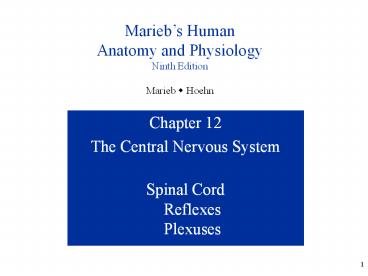Bio211 Lecture 19 - PowerPoint PPT Presentation
Title: Bio211 Lecture 19
1
Mariebs Human Anatomy and Physiology Ninth
Edition Marieb w Hoehn
Chapter 12 The Central Nervous System Spinal
CordReflexesPlexuses
2
Lecture Overview
- The spinal cord
- Spinal cord structure
- Spinal meninges
- Cross-sectional anatomy of the spinal cord
- Ascending and descending spinal tracts
- Reflexes
- Spinal Nerves
- Nerve plexuses
3
Spinal Cord Structure
- extends from the foramen magnum to 2nd lumbar
vertebra - cervical and lumbar enlargements
- cauda equina (horses tail) thin nerve fibers
that exit at different level than they arise
(note that spinal cord does not extend into this
area of the lumbar spine). Begins around L2 and
extends to S5. Good area for lumbar puncture and
collection of CSF.
Figure from Saladin, Anatomy Physiology,
McGraw Hill, 2007
4
Overview of the Spinal Cord
What type of vertebra is shown above?
5
Meninges of the Spinal Cord
Figure from Marieb Human Anatomy Physiology,
Pearson 2013
- dura mater outer, tough (anchoring dural
folds) - arachnoid mater web-like - pia
mater inner, delicate
- Subdural space like interstitial fluid
- Subarachnoid space CSF
6
Organization of Spinal Cord
Figure from Martini, Anatomy Physiology,
Prentice Hall, 2001
7
Organization of Spinal Gray Matter
Figure from Martini, Anatomy Physiology,
Prentice Hall, 2001
Posterior gray horn sensory Lateral gray horn
visceral motor Anterior gray horn somatic
motor Anterior root Posterior root
Gray matter dendrites and unmyelinated axons
8
Spinal Cord and Nerve Roots
Ventral root - axons of motor neurons whose cell
bodies are in spinal cord
Dorsal root - axons of sensory neurons in the
dorsal root ganglion
Dorsal root ganglion - cell bodies of sensory
neurons
9
Organization of Spinal White Matter
Figure from Martini, Anatomy Physiology,
Prentice Hall, 2001
White matter Myelinated axons
10
Functions of the Spinal Cord
The spinal cord
a. is a conduit for nerve impulses to and from
the brain (nerve tracts) b. is a center for
spinal reflexes
11
Tracts of the Spinal Cord
- Ascending tracts conduct sensory impulses to the
brain - Descending tracts conduct motor impulses from
the brain to motor neurons reaching muscles and
glands
All the axons in a tract share a common origin
and destination Tracts are usually named for
their place of origin (1st) and termination
(2nd) Most axons cross over during their travel.
What will this mean clinically?
12
Ascending Tracts
- fasciculus cuneatus/gracilis - fine touch,
pressure, body movement - cross
(decussate) in medulla - spinothalamic - crude pain, temperature,
pressure, and touch - cross in spinal cord - spinocerebellar - subconscious coordination
of muscle movements (1st and 2nd order
neurons) - ipsilateral
3
2
1
Decussation (crossing over)
13
1st, 2nd, and 3rd Order Sensory Neurons
1st order neuron from receptor to the spinal
cord (cell bodies are located in the dorsal root
ganglion) 2nd order neuron from spinal cord to
thalamus 3rd order neuron from thalamus to
sensory cerebral cortex - terminate in the
cerebral cortex
3
2
1
Decussation
14
Descending Tracts
- corticospinal (direct, pyramidal) - voluntary
movement of skeletal muscles - lateral
cross in medulla - contralateral - reticulospinal (indirect, extrapyramidal) -
subconscious muscle tone, sweat glands
- some lateral cross, anterior do not cross - rubrospinal (indirect, extrapyramidal) -
subconscious regulation of upper limb
tone/movement - cross in brain (less
important in humans)
Upper motor begin in precentral gyrus of cortex
Decussation
Lower
Upper MN Cerebral cortex to spinal cord Lower
MN Spinal cord to effector
15
Somatic Reflex Arcs
Reflexes automatic, subconscious, quick,
stereotyped responses to stimuli either within or
outside the body
They occur in both the somatic and autonomic
divisions
16
Knee-jerk (Stretch) Reflex
- helps maintain posture
Monosynaptic, Ipsilateral
17
Withdrawal Reflex
- protective
Polysynaptic, Ipsilateral, Intersegmental
18
Crossed-Extensor Reflex
- flexor muscles contract
- flexor muscles on opposite side inhibited
- extensor muscles on opposite side contract for
balance
Polysynaptic, Contralaterial, Intersegmental
19
Spinal Nerves
- mixed nerves
- 31 pairs
- 8 cervical (C1 to C8)
- 12 thoracic (T1 to T12)
- 5 lumbar (L1 to L5)
- 5 sacral (S1 to S5)
- 1 coccygeal (Co)
THIRTY ONEderful flavors of spinal nerves! Below
cervical spine, each spinal nerve leaves inferior
to the same numbered vertebra
Figure from Saladin, Anatomy Physiology,
McGraw Hill, 2007
20
Spinal Nerves
These are mixed nerves (sensory and motor
nerve fibers)
Ventral (anterior) ramus leads to formation of
plexuses
Spinal nerves are named according to the level of
the spinal cord from which they exit.
21
Cervical Plexus
Nerve plexus complex network formed by anterior
(ventral) branches of spinal nerves fibers of
various spinal nerves are sorted and recombined
Contains both sensory and motor fibers
- Cervical Plexus
- C1-C4
- lies deep in the neck
- supplies muscles and skin of the neck
- contributes to phrenic nerve (diaphragm)
Figure from Martini, Anatomy Physiology,
Prentice Hall, 2001
22
Brachial Plexus
- C5-T1
- lies deep within shoulders
- supplies shoulder and upper limbs
- musculocutaneous nerves
- supply muscles of anterior arms and skin of
forearms - ulnar nerves
- supply muscles of forearms and hands
- supply skin of hands
- radial nerves
- supply posterior muscles of arms and skin of
forearms and hands - axillary nerves
- supply muscles and skin of superior, lateral,
and posterior arms
23
Lumbosacral Plexus
- T12 S5
- supplies pelvis and lower limbs
- extend from lumbar region into pelvic cavity
- obturator nerves
- supply adductors of thighs
- femoral nerves
- supply muscles and skin of thighs and legs
- sciatic nerves
- supply muscles and skin of thighs, legs, and feet
May be separated into lumbar, sacral, pudendal,
and coccygeal plexuses
24
Classification of Nerve Fibers
SAME Sensory Afferent Motor Efferent
SOMAtic - Skin- BOnes- Muscles- Articulations
Table from Saladin, Anatomy Physiology, McGraw
Hill, 2007































